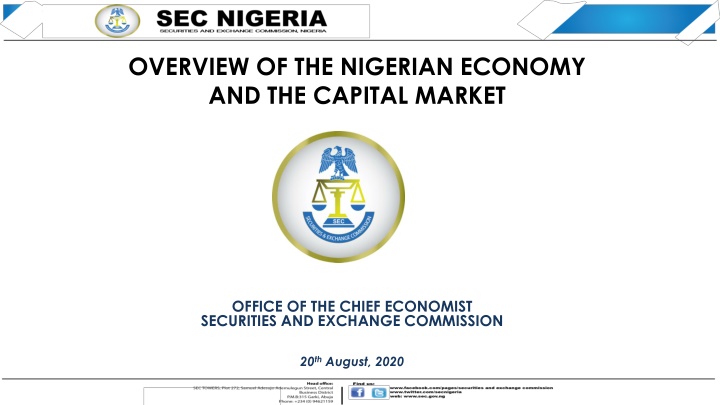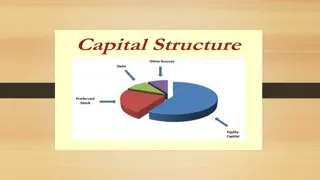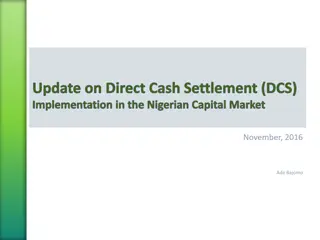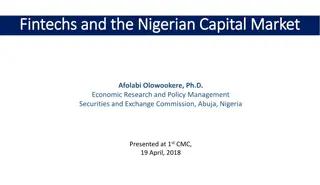Insights into Nigerian Economy and Capital Market
The Nigerian economy, as outlined by the chief economist of the Securities and Exchange Commission, experienced both growth and challenges in 2020. The global and domestic factors impacting the economy, such as unemployment, inflation, and sectoral growth rates, are discussed in detail. The data showcases the performance of various sectors and states in Nigeria, shedding light on the country's economic landscape amid the global economic downturn.
Download Presentation

Please find below an Image/Link to download the presentation.
The content on the website is provided AS IS for your information and personal use only. It may not be sold, licensed, or shared on other websites without obtaining consent from the author.If you encounter any issues during the download, it is possible that the publisher has removed the file from their server.
You are allowed to download the files provided on this website for personal or commercial use, subject to the condition that they are used lawfully. All files are the property of their respective owners.
The content on the website is provided AS IS for your information and personal use only. It may not be sold, licensed, or shared on other websites without obtaining consent from the author.
E N D
Presentation Transcript
OVERVIEW OF THE NIGERIAN ECONOMY AND THE CAPITAL MARKET OFFICE OF THE CHIEF ECONOMIST SECURITIES AND EXCHANGE COMMISSION 20th August, 2020
Table of Contents The Global Economy Domestic Output and Prices Employment External Sector Activities Oil and Commodities Market Market for New Issues (Primary Market) Secondary Markets Outlook
The Global Economy (IMF, WEO-JUNE 2020) Global growth weakened further in the first half of the due to Disruptions in global supply chains Falling global aggregate demand Increasing unemployment Rising sovereign and corporate debt Falling oil and commodity prices The International Monetary Fund (IMF) revised global growth projection down by 1.9% below April projections Large contractions projected economies The US recorded its worst economic performance since World War 2 China recovery from the sharp contraction in Q1 under way SSA countries recession in 2020 followed by slow recovery in 2021 Nigeria contraction in 2020 Falling oil prices Oil production cuts Country/Region World Advanced Eco. Euro Area EMs & Developing Sub-Sah. Africa 2018 3.6 2.2 1.9 4.5 3.2 2019 2.9 1.7 1.3 3.7 3.1 2020 -4.9 -8.0 -10.2 -3.0 -3.2 2021 5.4 4.8 6.0 5.9 3.4 for advanced United States United Kingdom .. China India Brazil South Africa 2.9 1.3 2.3 1.4 -8.0 -10.2 4.5 6.3 6.7 6.1 1.3 0.8 6.1 4.2 1.1 0.2 1.0 -4.5 -9.1 -8.0 8.2 6.0 3.6 3.5 Nigeria 1.9 2.2 -5.4 2.6
Output and Prices The Nigerian economy expanded by 1.87% in Q1 20. 0.23% lower than Q1 19 growth. Effect of COVID-19 restrictions. Contraction expected in Q2 20. Main drivers of growth: Agriculture and Industry sectors. Sector Growth rate (%) Agriculture Industries Services Real Growth rate Non-oil Growth Q1-19 Q2-19 Q3-19 Q4-19 Total Q1-20 3.17 0.42 2.41 2.10 2.47 1.79 2.84 1.94 2.12 1.64 2.28 3.21 1.87 2.28 1.85 2.31 2.75 2.60 2.55 2.26 2.36 2.31 2.22 2.27 2.06 2.20 2.26 1.57 1.87 1.55 Headline inflation rose to 12.82% in Jul 20, driven by Lockdown of the economy Planting season effects Exchange rate adjustments Inflationary pressure expected to persist from: Supply chain disruptions Demand pressures from easing of lockdown High energy costs Unemployment rate now at 27.1% in Q2 20 Unemployment + underemployment is 55.7% From 23.94% and 46.74% in Q3 18 Headline Inflation (%) 12.82 12.56 12.1312.2012.2612.3412.40 11.98 11.85 11.61 11.37 11.40 11.3711.3111.25 11.24 11.22 11.0811.02 Jul-19 Jul-20 Jun-19 Jun-20 Apr-19 May-19 Nov-19 Apr-20 May-20 Aug-19 Jan-19 Mar-19 Dec-19 Jan-20 Mar-20 Feb-19 Sep-19 Feb-20 Oct-19
Unemployment Unemployment rate now at 27.1% in Q2 20 Unemployment + underemployment is 55.7% From 23.94% and 46.74% in Q3 18 The performance of individual states give some insights. 48.7 45.2 43.7 40.3 39.8 39.4 36.0 35.5 35.2 33.8 33.3 31.6 31.6 29.3 29.1 27.8 27.2 27.1 26.8 23.6 23.4 22.4 21.9 21.1 19.9 19.5 19.0 16.4 16.3 16.1 16.0 15.5 15.3 14.6 14.0 13.9 13.8 13.1 Cross River Akwa-Ibom Kaduna Taraba Kwara Adamawa Delta Plateau Yobe Edo Zamfara Anambra Rivers Ondo Gombe Fct Jigawa Bauchi Sokoto Enugu Katsina Ogun Imo Nasarawa Benue Oyo Kebbi Abia Niger Lagos Kogi Bayelsa Borno Osun Ebonyi Kano National Ekiti
External Sector External Reserves ($bn) Gross external reserves has been falling steadily for several months Fell to $35.88bn in Jul 20 from $44.90bn in Jul 19 Further reserve depletion expected CBN s foreign exchange intervention Fall in global oil price. Can still cover about nine months imports. 47.79 47.61 47.49 47.12 46.26 45.84 45.12 45.07 44.90 44.79 44.43 44.31 43.61 43.17 43.12 42.49 42.31 42.17 42.00 41.85 40.69 40.46 39.80 38.60 38.01 36.59 36.30 36.19 35.88 35.54 35.16 The naira has depreciated across the various segments of the market. Rate at the I&EFX window depreciated to N389.25/$ at the end of July from N364.79/$ at the beginning of the year. Parallel rates for the same period were N475/$ and N362/$ The CBN adjusted official rate from N361/$ to N380/$ in August 2nd time in the last six months Foreign exchange intervention in the future may be limited by the steady depletion of reserve. Jul-18 Jul-19 Jul-20 Jun-18 Jun-19 Jun-20 Apr-18 May-18 Apr-19 May-19 Apr-20 May-20 Mar-18 Dec-18 Mar-19 Dec-19 Mar-20 Feb-18 Aug-18 Sep-18 Nov-18 Feb-19 Aug-19 Sep-19 Nov-19 Feb-20 Jan-18 Jan-19 Jan-20 Oct-18 Oct-19 Official Parallel 500.00 400.00 300.00 200.00 100.00 0.00 Jul-18 Jul-19 Jun-18 Jun-19 Jun-20 Apr-18 May-18 Apr-19 May-19 Apr-20 May-20 Nov-18 Dec-18 Nov-19 Dec-19 Aug-18 Aug-19 Jan-18 Mar-18 Jan-19 Mar-19 Jan-20 Mar-20 Feb-18 Sep-18 Feb-19 Sep-19 Feb-20 Oct-18 Oct-19
Oil Price and Production (OPEC) Crude oil production in July 2020 declined to 1.37mbpd Oil output expected to increase with the relaxation of OPEC supply cuts But not likely for defaulters like the Nigeria The Nigerian economy is more sensitive to oil production than prices. Production cuts will impact oil revenues 2.50 1.96 1.83 1.80 1.80 1.80 1.78 1.76 1.74 1.74 1.73 1.72 1.71 1.71 1.69 1.67 1.66 1.66 1.65 1.65 1.64 1.64 1.64 1.63 2.00 1.58 1.56 1.53 1.50 1.45 1.44 1.41 1.37 Production (mbp) 1.50 1.00 0.50 0.00 Apr-18 Apr-19 Apr-20 May-18 May-19 May-20 Dec-18 Dec-19 Mar-18 Mar-19 Mar-20 Jan-18 Aug-18 Oct-18 Jan-19 Aug-19 Oct-19 Jan-20 Jun-18 Jun-19 Jun-20 Jul-18 Nov-18 Jul-19 Nov-19 Jul-20 Feb-18 Sep-18 Feb-19 Sep-19 Feb-20 82.09 79.45 77.73 100 75.06 74.86 73.29 72.81 72.75 72.24 69.92 68.18 67.71 67.05 66.02 65.95 65.90 65.89 65.59 65.19 64.02 63.69 61.45 60.51 60.46 57.82 57.77 57.77 80 Crude oil price (Bonny Light) averaged US$43.46/b in July 2020 Brent Crude price was $43.30/b during the same period Slight recovery in global demand and output cuts raised prices Ease in OPEC output cut will likely impact prices 43.46 Price (US$/b) 39.03 60 24.86 40 15.54 20 0 Apr-18 Apr-19 Apr-20 Dec-18 Dec-19 Mar-18 May-18 Mar-19 May-19 Mar-20 May-20 Aug-18 Oct-18 Aug-19 Oct-19 Jun-18 Jun-19 Jun-20 Jan-18 Nov-18 Jan-19 Nov-19 Jan-20 Feb-18 Sep-18 Feb-19 Sep-19 Feb-20 Jul-18 Jul-19 Jul-20
Primary Capital Market Activities FGN bonds dominate the primary market FGN issued N1.49 trillion worth of bonds from Jan-Jul 2020. Equities issued during the same period amounted to N36.35 billion. Mostly right issues placements In the corporate bond segment bonds worth N526.2 billion were issued Higher than the N168.72 recorded in 2019 Capital market more patronised Two Subnational bonds were issued Valued at N150 billion New Issues 1742.29 1550.46 1487.10 1308.30 and private 918.94 526.20 473.14 323.59 306.50 211.09 168.72 150.00 114.80 103.17 97.39 47.00 36.35 23.15 11.73 0.00 2016 2017 2018 2019 2020 Equities (N'B) FGN Bonds (N'B) Corporate Bonds (N'B) Sub-National Bonds (N'B)
Secondary Market - NSE Market fluctuating during the year. The NSE ASI finished the month of July at 24,693.73 points Lost 8.0% year-to-date Market capitalisation was N12.88 trillion Lost 0.67% year-to-date Market drivers Weak corporate results/earnings Unstable environments Rising inflation ASI 25,136.49, Market capitalization N13.11 trillion (18/8/20) Year-to-date growth ASI -6.35%, market capitalization 1.19% performance has been 50.00 18.00 45.00 16.00 40.00 14.00 35.00 12.00 30.00 Thousand points 10.00 25.00 Trillion naira 8.00 20.00 6.00 15.00 4.00 10.00 2.00 5.00 0.00 0.00 Jan-18 Apr-18 Jul-18 Nov-18 Jan-19 Apr-19 Jul-19 Nov-19 Jan-20 Apr-20 Jul-20 Feb-18 Mar-18 Sep-18 Feb-19 Mar-19 Sep-19 Feb-20 Mar-20 Aug-18 Aug-19 Dec-18 Dec-19 Jun-18 Oct-18 Jun-19 Oct-19 Jun-20 May-18 May-19 May-20 macroeconomic Market Capitalization All Share Index
Secondary Market - FMDQ Total turnover at the end of June 2020 was N16.47 trillion Total turnover in June 2019 N19.12 trillion A decrease of 13.8% Treasury Bills, as usual, dominate the market, 30% of total turnover in 2020, followed by Agreements/Buy Backs at 19.6%. Activities at the bond market were dominated by the Federal Instruments FGN issuances were over 90% of total bond 40,000,000 35,000,000 30,000,000 25,000,000 20,000,000 15,000,000 10,000,000 Repurchase 5,000,000 - Jul-18 Jul-19 Jun-18 Jun-19 Jun-20 Apr-18 May-18 Apr-19 May-19 Apr-20 May-20 Nov-18 Nov-19 Jan-18 Mar-18 Dec-18 Jan-19 Mar-19 Dec-19 Jan-20 Mar-20 Feb-18 Aug-18 Sep-18 Feb-19 Aug-19 Sep-19 Feb-20 Oct-18 Oct-19 -5,000,000 Foreign Exchange Foreign Exchange Derivatives Treasury Bills OMO Bills FGN Bonds Other Bonds* Eurobonds Repurchase Agreements/Buy-Backs Unsecured Placements/Takings Money Market Derivatives Commercial Papers
Secondary Market NASD NASD - Value of Trades (N Bn) 11.52 Trade on the floor of the NASD was valued at N277.82 million as at the end of June 2020. 7.78 Value dropped by 57.12% year on year. 6.31 Total value in 2020 N7.69 billion 0.9% lower than the total value in the first half 3.63 3.43 of 2019 (N7.6 billion) 1.55 1.9 1.11 1.09 1.07 1.04 0.99 1.3 0.65 0.65 0.59 0.57 0.52 0.44 0.43 0.40 0.38 0.38 0.33 0.33 0.33 0.30 0.28 0.18 0.00 Apr-18 May-18 Apr-19 May-19 Apr-20 May-20 Mar-18 Dec-18 Mar-19 Dec-19 Mar-20 Aug-18 Oct-18 Aug-19 Oct-19 Jun-18 Jun-19 Jun-20 Jan-18 Nov-18 Jan-19 Nov-19 Jan-20 Feb-18 Sep-18 Feb-19 Sep-19 Feb-20 Jul-18 Jul-19
Outlook Economy Global growth expected to contract in 2020. Oil prices have slumped over weakened demand Current oil price is $45.40/barrel Domestic the GDP is expected to contract The IMF revised growth projection downwards (from -3.4% to -5.4%) Moderate growth expected in Q2, going by the PMI trend (July CBN PMI 44.9 from 41.1 in June) Inflation and interest rate exchange rate controls as well as fiscal spending are expected to raise inflation rate. Government borrowing Crowding out effect Debt sustainability issues Foreign exchange risk Job creation and sustainable development Still challenging Insurgency Unemployment rate rose to 27.1% in Q2 2020 Capital market Macroeconomic Weak global and domestic economic condition will continue to affect Some sectors are more resilient Technology A good leverage for early starters Regulatory New management focus on market confidence, efficiency and compliance























